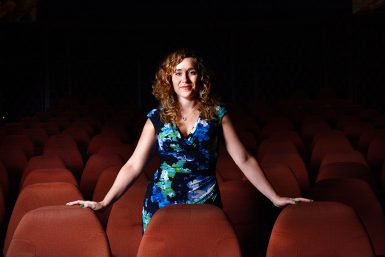IU Cinema supports film studies, offers entertainment

The IU Cinema bills itself as a place for film, and since it opened five years ago, it has lived up to its name by dedicating itself to the scholarly study of film as well as a venue for seeing avant garde work, new films and just-plain-fun blockbusters.
And Media School students and professors are relying on the cinema for collaboration and exposure to new kinds of film.
“The films and experiences that it offers undergraduates allow them a chance to expand their ideas of what film can be,” said doctoral student and film studies instructor Russell Sheaffer.
That includes experimental film, which Sheaffer produces and teaches, including a class on 16mm film production. His own work has been shown at the theater, including two shorts and one feature.
“I’ve been really impressed with so much of the programming at IU Cinema,” Sheaffer said. “But I’m so appreciative and inspired by the cinema’s devotion to programming experimental and underground work.”
The IU Cinema programs series every semester that link campus to the cinema world. It’s been home to the Diabolique International Film Festival, which brought independent horror and sci-fi filmmakers from across the country to campus to screen their works. It also hosts the Underground Film Series, which showed shorts, documentaries and feature length films of independent directors, and the City Lights series, both of which were sponsored by the school.
The IU Cinema regularly offers for undergrads to have their work screened, too. The Double Exposure film series teams up Media School students, Jacobs School of Music composers and a live orchestra to show silent films made by film students every spring. Each semester, the showcase of the best student films features work from several classes.
Brittany Friesner, BAJ’98, interim director at IU Cinema, said the organization works hard to provide a variety of film – including student-made – to satisfy its mission as a place for all kinds of visual imagery and access to people who produce and study it. For example, many series are designed around one genre or one director, with Q&A sessions with producers, directors or scholars after the screenings. This philosophy has brought renowned directors such as John Waters and Werner Herzog to campus, where they took to the stage to talk about their work after screenings.
But some students barely realize the cinema exists. The cinema has partnered with 49 departments and organizations on campus, showing many films that are part of coursework. Some students “discover” the cinema from that experience.
Others come to the films from the special program, Directed by Women, or selections from the International Arthouse Series. Many are drawn to special events, such as the recent sneak preview of mainstream films such as Spotlight, which was shown a week before its national release date.

But movies are made to entertain, and the cinema shows those, too. Rocky Horror Picture Show, The Big Lebowski and Duck Soup were big hits this fall.
“We’re also showing Jaws,” Friesner said. “We’re a place where you can come and have fun.”
Aside from speakers and guest lecturers that appeal to students, Friesner said she wants the cinema to program more film genres that appeal to students.
“Like Hayao Miyazaki, My Neighbor Totoro,” Friesner said. “I think anime will appeal to students, but that it’ll have a broader appeal in the community.”
Putting the classics on the big screen is an opportunity for film students to see films as they were when they originally released. The cinema, for example, hosted a back-to-back-to-back screening on Back to the Future this fall. It celebrated the day Marty McFly traveled forward in time with the screening and having the iconic DeLorean car outside the building.
“I think our tactic up until now has been like convincing a toddler to eat his vegetables,” Friesner said. “We want to get them in here with Tremors or Poltergeist or Wizard of Oz and hope they realize that they had such a good experience that they take a chance on something else.”
For film students and scholars, though, the IU Cinema is hardly eating vegetables. The IU Cinema regularly partners with the groups like the Black Film Center/Archive and the recently established Center for Documentary Research and Practice to show screenings and host guest directors.
This semester alone, the BFC/A has partnered with the IU Cinema to show films by Senegalese director Ousmane Sembene. It also hosted an international symposium on the 1915 silent film The Birth of a Nation.
“In the few years of this young partnership, our programs together and with our many co-sponsors have just begun to explore the full scope of over a century of black cinema,” said Brian Graney, senior archivist at the BFC/A, via email. “What’s further, our programming partnership is just the beginning of the black film offerings at the IU Cinema, with many more originating through their own curation and through other campus partnerships.”

Sheaffer said that, as an instructor and a director, going to the cinema is important for film students because it’s a way to expose themselves to new films they’d otherwise not see.
“I try to get my students to go to the cinema as often as possible,” Sheaffer said. “It’s such a great resource and one that undergrads can’t take advantage of enough.”
Michael T. Martin, director of the Black Film Center/Archive, calls the cinema the “hub” of campus film exhibition and study, a venue that is responsible for the renaissance of film on the IU campus.
“When you observe the splendor of the theater, provisioned by state-of-the-art viewing platforms, how can you not be impressed?” he said.
More:

